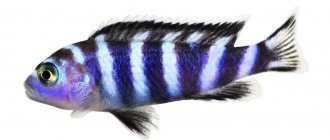What will you learn from the article?
- When is it necessary to bathe?
- At what age can you bathe a kitten?
- When can you bathe a kitten?
- How often can you bathe a cat?
- How to bathe a cat at home?
- How to bathe a cat? Industrial bathing products - popular brands
- Folk remedies for bathing
Bathing a kitten is a procedure whose feasibility can be debated. First of all, it's problematic. Secondly, it is stressful for most fluffies, who are not known for their love of water. Thirdly, cats are recognized cleanliness; they spend half their waking time washing themselves. But, there are cases when you can’t do without swimming.
Let's look in detail at what age you can bathe a cat, how to make this procedure less unpleasant, and get acquainted with the best bathing products.
When is it necessary to bathe?
Nature has endowed cats with their own hygiene complex. The rough tongue of fluffies does an excellent job of removing dirt and foreign odors from the animal’s coat; it combs the fur, increasing its thermal insulating properties.
To interfere with this natural process means to disrupt the natural protective layer of skin and fur. They bathe a cat only when the animal cannot clean itself up on its own or as part of therapeutic and preventive procedures.
Bathing is necessary:
- In case of heavy contamination: soot, oil, swamp slurry, something foul-smelling.
- If the animal is picked up from the street and it is very dirty, infested with fleas.
- Cats who returned from the street after the “sexual hunt”.
- Hairless breeds of cats - their body produces a lot of skin lubricant, which will emit an unpleasant odor if it is not washed off in time.
- Older animals and obese cats who cannot clean their fur on their own.
- Show class animals that participate in exhibitions.
- Cats with parasitic diseases (fleas), ringworm. In this case, special therapeutic and prophylactic agents are used.
- Long-haired breeds during the molting period. During shedding, more villi enter the cat's stomach - this can cause digestive problems and intestinal blockage. Bathing will wash away dead fibers - the cat will swallow less hair, and the house will be cleaner.
Important!
Remember that cats are not dogs; advice on bathing dogs should not be applied to cats.
Is it necessary to bathe a kitten?
In most cases, adult animals cope with hygiene procedures on their own; in kittens this skill is not yet very developed.
Kittens are still not very good at washing themselves
Reasons to wash your baby
Since we discovered the ability to keep our bodies clean with water, bathing has been a natural procedure for us. The situation is a little different with animals, but there are cases when bathing is necessary.
- The animal was taken from the street. In this case, it must be washed immediately. After all, along with your kitten, you can bring parasites into your home.
A kitten found on the street should be washed immediately - The kitten got very dirty. Natural curiosity sometimes leads to such consequences.
- Fleas, fungus or lichen are another reason for bath procedures. It is better to combine them with medicinal ones.
- Shedding. Lost hairs are much easier to remove while bathing. Cleaning will become easier, and much less hair will end up in the baby’s stomach.
- After bathing, the pet looks more well-groomed, the fur becomes softer and smells good.
After a bath, the kitten looks more well-groomed
It has been observed that after bathing a pet, those who are allergic to animal fur feel much better.
At what age should you have your first bath?
It is recommended to start bathing procedures at an early age. This way, the kitten will get used to bathing from childhood and in the future will treat washing calmly.
According to experts, it is best to take the first bath at the age of 2 months. Until this moment, the baby’s mother successfully copes with hygiene. And the kitten’s body temperature is unstable; bathing can do him more harm than good.
How often to wash a kitten
Don’t get too carried away with water procedures; frequent bathing will harm your baby. Along with the dirt, the protective fat layer is washed away, the animal's skin and fur become dry, and dandruff appears.
Opinions differ on the frequency of bathing. Some believe that once every 2-3 months is enough, others suggest doing it every week. As always, the truth is somewhere in the middle.
A reasonable schedule seems to be once a week during shedding and once every two weeks the rest of the time. Unscheduled baths cannot be ruled out when the baby gets into something, has an unsuccessful trip to the toilet, or picks up parasites. But for frequent washing, you need to choose a gentle shampoo.
The older the kitten, the less often it should be washed.
As they grow older, the frequency of bathing decreases; an adult animal only needs to be washed once every two to three months. Some experts even recommend doing this no more than twice a year.
At what age can you bathe a kitten?
A healthy kitten's first bath should occur no earlier than 4-5 months of age, when its baby teeth fall out.
At this age, babies experience stress from contact with water more easily, and they have already been weaned from their mother.
Bathing newborn kittens is unnecessary and harmful. Firstly, up to 1-3 months they are looked after by their mother; the cat’s rough tongue and saliva clean the kittens’ fur better than detergents. Bathing at an early age will wash away the natural postpartum lubricant that protects the baby from various infections.
Water procedures with shampoo or soap will kill the baby’s own smell - the mother cat may refuse him, stop feeding him, or even suffocate him. The third argument against early bathing is that newborn kittens have poor heat exchange, they can freeze after water procedures and catch a cold.
The only reason you might want to give your kitten a bath at an earlier age is if there is a flea infestation. Newborn kittens are not suitable for parasite treatments for adult animals. Bathing with anti-parasitic shampoo is the only possible way to treat kittens from 1 month. It is important to choose a brand of shampoo that is approved for babies.
IMPORTANT!
After vaccination, the kitten should not be bathed for at least two weeks.
10 days must pass after castration.
If you notice signs of lichen in your purr, the veterinarian has prescribed proper treatment, then he should warn that swimming with lichen is not prohibited, but is even recommended. But, since this procedure is therapeutic and is carried out with special means, we will talk about it in another article.
When can you bathe a kitten?
The allowed frequency of bathing kittens is 2-3 times a year!
Not per month, and not per week, but per year. There is no need to arrange frequent spa treatments for your kids just because the owners want it. The fur and skin of kittens are covered with a special protective layer that helps regulate heat exchange and protects against infections. Frequent bathing will disrupt this natural protective film.
A kitten cared for by a mother cat, as well as a clean kitten living at home, does not need water treatments at all. The most you can do with these babies is to wipe the soiled coat, paws or area around the anus with a damp baby wipe. There is no need to expose the baby’s vulnerable psyche to severe stress - water procedures cause a negative reaction in almost all kittens.
Of course, there are exceptions to the rules. There are kittens that show interest in water, the bathroom and shower. For example, babies of the Bengal breed, Norwegian forest cat and Maine Coon breed love to swim. There are individuals with a passion for water among other breeds.
Such pets should not be denied the pleasure of playing with a babbling stream or deprived of the opportunity to swim. The main thing is to make sure that the baby does not get too cold. Wipe it dry after bathing, dry it with a hairdryer, and keep it in a draft-free room until completely dry.
How often can you bathe a cat?
A healthy adult cat can be bathed as often as a kitten - once every two to three months. Sick animals for whom the veterinarian has prescribed baths with special therapeutic and prophylactic agents are bathed with the frequency specified by the doctor.
If your cat is pregnant, then bathing it is highly undesirable! There is no need to expose a pregnant animal to stress - this can negatively affect its pregnancy and offspring. In case of severe contamination, wipe the cat with a damp sponge, while not forgetting to talk soothingly to the expectant mother.
If necessary, you can wash a nursing cat, and we will tell you how to do it correctly. If the animal is afraid of water, then it is better to simply gently wipe the body around the nipples with a damp cloth without using detergents! And if the cat is accustomed to water, then comfortable swimming in water at the right temperature will help the woman in labor quickly restore her appearance.
Bathing an adult cat
Water procedures for an adult pet are not much different from bathing a baby.
You shouldn't bathe your cat often. In fact, this should only be done when there is a special reason: severe soiling after a walk, getting rid of fleas or other skin diseases, preparing for an exhibition.
However, let's add some details.
- Prepare for bathing
: put on gloves, trim your cat’s claws, you can light aromatic candles a couple of minutes before the procedure begins. An adult cat can be washed in the bath. To prevent the animal from slipping, cover the bottom with a towel. - The next task
is to thoroughly wet the cat's fur. This can be done with a sponge. Bathing water for an adult cat may be cooler than for a kitten. - Slowly lather the coat
with shampoo and massage. For purebred animals, buy only. - Brush off
the foam. - Rinse it off with warm water
from a mug without touching the cat's head - you can simply wipe it off. - Dry the wool with a towel
without rubbing, so as not to create tangles. Then pat dry again. - After bathing,
be sure to give your cat a treat.
Only long-haired cats can be dried with a hairdryer. To dry and not get sick, the cat must spend more than 12 hours in a warm room.
Regarding the use of regular shampoo
for bathing a cat - the recommendation is the same: if it is absolutely impossible to purchase a special shampoo, use a children's shampoo, but not two-in-one.
If your cat has not been trained since childhood and is very afraid of water
, in most cases you can get by.
How often should you bathe an adult cat?
A pregnant cat should not be bathed
– this is a huge stress for the expectant mother. Postpone the procedure, using dry shampoo and combing during this period.
if the animal gets dirty with something oily, lubricate the stain with butter before bathing, massage and blot with a napkin;
when removing fleas, when bathing, first wet the cat’s neck so that fleas cannot “escape” onto her head;
If your cat shakes violently for more than 5 minutes after a bath, dry it with a hairdryer or wrap it in a towel to protect it from pneumonia.
What to do if your pet falls from a great height:
How to bathe a cat at home?
Bathing a cat can be comfortable if you follow some rules. First, find yourself a partner. A cat is a small creature, but bathing it with four hands is more convenient. One holds the animal, and the second carries out manipulations.
Next, step-by-step instructions on how to properly bathe a cat at home .
Before you bring your pet into the bathroom, prepare everything you need.
List of what you will need:
- medium-sized shallow basin;
- a saucepan with warm water;
- ladle;
- cotton wool;
- sponge;
- brush;
- detergents;
- a set of terry towels;
- hair dryer;
- delicacy;
- rubber gloves (we reserve this item for those animals that fundamentally do not submit to the “humiliating” need to be clean by force and tear their owners’ hands to shreds with their claws);
- nail clipper
Step 1: Prudent.
Combine business with pleasure and trim your pet's nails. You remember that this needs to be done from time to time? This procedure before bathing is also intended to once again protect you from the wrath of your pet. However, there are radical methods for permanently declawing a cat, but we are not talking about extreme measures now.
Step 2. Preliminary.
Pour water into a bowl and into a saucepan. At what temperature should you bathe a cat? Considering that a cat’s body temperature is higher than that of a person, a water temperature of 30-38 degrees will be comfortable for it. But bathing in a large bathtub cannot be called comfortable for a cat, since huge expanses of water will plunge the cat into panic. A bowl of warm water is sufficient for cat procedures. Bring towels into the bathroom in advance and open bottles of detergent.
Step 3: Discreet.
Plug the animal's ears with cotton swabs to prevent water from entering. And only after that bring the cat into the bathroom.
Step 4. Extreme (as well as all subsequent steps).
How to bathe a kitten if it panics? In cold blood! Talk to him in a calm voice, showing that you are the boss of this flock and know what you are doing.
Don’t put the baby in a bowl of water right away, just wet the woolen coat as much as possible with a sponge soaked in water, trying not to scare the cat with random noise. This is why we recommended pouring water in advance.
Then you should take the detergent and rub it into the fur slowly, carefully, with massaging movements. Is it worth reminding us that we try not to get the cat’s head wet at all?
Step 5.
Use a brush to very carefully remove the resulting foam and then place the cat in the basin, pouring water from the ladle over it. If there is not enough water, then you will need an additional portion, poured into the saucepan in advance. The cat will be calmer in the basin if there is something there that he can grab onto with his claws. Some owners put the animal directly into a bowl of water, some put it in an empty basin - you can only choose your option experimentally.
The eyes and ears (outside) can be wiped with a damp hand.
Step 6.
Finally, we wrap the cat in a towel and try to hold it so that the wet animal in the wild does not become hypothermic. Rubbing with a towel is harmful to the coat, so we only blot the moisture, changing towels as needed.
Step 7
The next step is blow drying. We hold the scary and buzzing device at a distance of 30 cm from the animal’s body. Some experts convince that only long-haired cats should be blow-dried, but it seems to us that to prevent colds, it is better not to pay attention to the length of the coat, because the cat itself takes a long time to dry. If you leave a cat in a warm room after bathing, it will dry completely only after 12 hours!
Step 8
We comb out the fur with special combs and brushes, thus finally removing dead hair.
Step 9
We motivate the dried and combed cat with a treat, so that next time bathing will be associated only with pleasant moments.
Cleanliness is in the blood
Looking at how thoroughly a cat licks itself several times a day, how quickly and efficiently its rough tongue sweeps away all obstacles in the form of dirt, dust and specks entangled in its fur, some owners cannot even think that cats need to be washed additionally. But do not shift all hygiene responsibilities to your pet, since he still needs bathing.
- Look at the cat. It does an excellent job of keeping the coat clean. Now look out the window. Most likely, you will see a lot of cars, people, other animals, as well as mountains of garbage and dirt. All this settles on your pet’s fur, accumulates on it day after day, and then goes straight into the stomach. Even domestic cats need to be cleaned, since the owners bring litter and dust into the house on their shoes.
- Seasonal shedding is an inevitable period in a pet’s life. He washes himself with the same thoroughness, but where does most of the hair that has already fallen out end up? That's right, into the cat's stomach. Lucky cats simply present surprises to their owners in the form of regurgitation of fur onto their favorite carpet, while less fortunate cats may experience intestinal obstruction.
- There can be no question of neglecting to bathe a cat that is infected with fleas or is soiled with something that can get into the stomach and harm it.
These reasons deserve attention, but you shouldn’t drop everything and drag your pet into the bath for treatments. We come to the main question: how many times to bathe a cat.
How to bathe a cat?
In pet salons, specialists use dozens of means and methods to clean up your pet, but caring for a kitten at home is simplified and one or two will be enough for you.
The first rule is that you cannot bathe your cat with shampoos for people or products for dogs - they can be dangerously toxic for your pet. Pet stores offer many special shampoos for cats - choose one that matches the type of your animal.
Shampoos for cats:
- Sprays – clean the animal’s fur and work as antistatic agents;
- Dry shampoos – powder (dry) products are suitable for cats that have not overcome hydrophobia;
- Liquid is the most common form for cats that have overcome their fear of water.
Industrial bathing products - popular brands
Manufacturers offer conventional cleansing shampoos and bathing products with targeted action: against dandruff, against allergies, against hair loss, against fleas, and lichen.
Popular brands:
- Beaphar Shampoo Hypo-allergenic – hypoallergenic shampoo.
- VEDA Phytoelite is an anti-matt shampoo for fluffy cats.
- CLINY – shampoo-conditioner.
- Beaphar Shampooing Chats & chatons – for cats and kittens.
- Bio-Groom “Klean Kitty” – spray shampoo.
- Ms Kiss “Freshness and Volume” – dry shampoo.
- Mr.Gee – dry shampoo with mint.
- Beaphar Shampoo Anti Dandruff - anti-dandruff shampoo.
- RolfClub – insecticidal shampoo.
- Beaphar Shampoo Anti-Itch – anti-itch shampoo.











